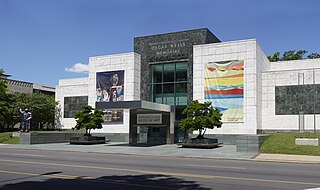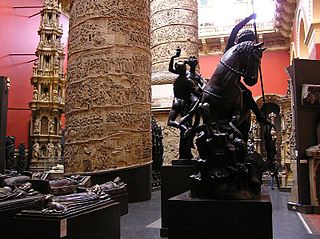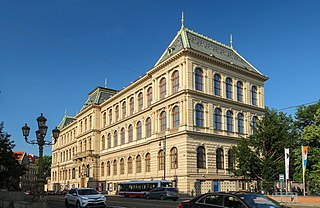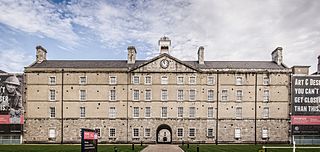
The Victoria and Albert Museum in London is the world's largest museum of applied arts, decorative arts and design, housing a permanent collection of over 2.27 million objects. It was founded in 1852 and named after Queen Victoria and Prince Albert.

The Los Angeles County Museum of Art (LACMA) is an art museum located on Wilshire Boulevard in the Miracle Mile vicinity of Los Angeles. LACMA is on Museum Row, adjacent to the La Brea Tar Pits.

The Carnegie Museum of Art is an art museum in the Oakland neighborhood of Pittsburgh, Pennsylvania. The museum was originally known as the Department of Fine Arts, Carnegie Institute and was formerly located at what is now the Main Branch of the Carnegie Library of Pittsburgh. The museum's first gallery was opened for public use on November 5, 1895. Over the years, the gallery vastly increased in size, with a new building on Forbes Avenue built in 1907. In 1963, the name was officially changed to Museum of Art, Carnegie Institute. The size of the gallery has tripled over time, and it was officially renamed in 1986 to "Carnegie Museum of Art" to indicate it clearly as one of the four Carnegie Museums.

The Birmingham Museum of Art is a museum in Birmingham, Alabama. Its collection includes more than 24,000 paintings, sculptures, prints, drawings, and decorative arts representing various cultures, including Asian, European, American, African, Pre-Columbian, and Native American. The museum is also home to some Renaissance and Baroque paintings, sculptures,and decorative arts from the late 13th century to c. 1750.

The Cast Courts of the Victoria and Albert Museum in London, England, comprise two large halls. Unusually for a museum, the Cast Courts house a collection not of originals, but copies. Here are to be found reproductions of some of the most famous sculptures in the world. Most of the copies were made in the 19th century and in many cases they have better resisted the ravages of time, 20th-century pollution and over-zealous conservation than the originals. In a few cases, such as the late 15th century Lübeck relief of Christ washing the Apostles' feet, the original has been destroyed and the cast is a unique record of a lost work.

The Musée des Arts Décoratifs is a museum in Paris, France, dedicated to the exhibition and preservation of the decorative arts. Located in the city’s 1st arrondissement, the museum occupies the Pavillon de Marsan, the north-western wing of the Palais du Louvre. With approximately one million objects in its collection, the Musée des Arts Décoratifs is the largest museum of decorative arts in continental Europe. It is one of three museums operated by the non-profit arts association MAD, founded in 1882.

The Museum of Art, Rhode Island School of Design is an art museum integrated with the Rhode Island School of Design, in Providence, Rhode Island, US. The museum was co-founded with the school in 1877. It is the 20th-largest art museum in the United States, and has seven curatorial departments.

Founded in 1885, the Prague Museum of Decorative Arts is housed in a Neo-Renaissance edifice built from 1897 to 1899 after the designs of architect Josef Schulz. It opened in 1900 with exhibitions on the first floor. The Museum's rich collections include decorative and applied arts and design work ranging from Late Antiquity to the present day with focus on European objects, particularly arts and crafts created in the Bohemian lands. The impressive interior of the permanent exhibition, “Stories of Materials,” offers visitors an excursion into the history and development of decorative arts in the disciplines of glass, ceramics, graphic art, design, metal, wood and other materials, as well as objects such as jewellery, clocks and watches, textiles, fashion, toys and furniture.

The Fonthill Vase, also called the Gaignières-Fonthill Vase after François Roger de Gaignières and William Beckford's Fonthill Abbey, is a bluish-white Qingbai Chinese porcelain vase dated to 1300–1340 AD. It is famous as the earliest documented Chinese porcelain object to have reached Europe.

The National Museum of Ireland – Decorative Arts and History is a branch of the National Museum of Ireland (NMI) located at the former Collins Barracks in the Arbour Hill area of Dublin, Ireland.

John Paul Miller was an American jewellery designer and goldsmith, who also produced films, photographs and paintings. Stephen Harrison, decorative arts curator at the Cleveland Museum of Art, compares Miller's work with that of René Lalique and Louis Comfort Tiffany.
James Parker was an American art historian. He served for nearly three decades as a curator at The Metropolitan Museum of Art.
Charlotte Cotton is a curator of and writer about photography.
Sir Arthur Gilbert was a British-born American real estate developer, art collector and philanthropist.
Myra Mimlitsch-Gray is an American metalsmith, artist, critic, and educator living and working in Stone Ridge, New York. Mimlitsch-Gray's work has been shown nationally at such venues as the John Michael Kohler Arts Center, Museum of the City of New York, Metropolitan Museum of Art, Cooper-Hewitt Smithsonian Design Museum, and Museum of Arts and Design. Her work has shown internationally at such venues as the Middlesbrough Institute of Modern Art, Stadtisches Museum Gottingen, and the Victoria and Albert Museum, and is held in public and private collections in the U.S, Europe, and Asia.
Philippa Jane Glanville , OBE, FSA, formerly chief curator of the metal, silver and jewellery department of the Victoria and Albert Museum, is an English art historian who is an authority on silver and the history of dining.

English Silver Before the Civil War is Timothy Schroder's account of English domestic and church silver from a little before the Tudor age (1485–1603) to the threshold of the Civil War (1642–51).

Charles Henry Truman, FSA, was an art historian and a leading authority on gold boxes.

The Usher Gallery is an art museum in Lincoln, England. The gallery displays a collection of artworks by painters such as J. M. W. Turner and L. S. Lowry. Established in 1927, it is run as part of the Collection.

Concealed Histories: Uncovering the Story of Nazi Looting was an exhibition at the Victoria & Albert Museum in London that ran from December 2019 until July 2021. It was the first Nazi-era provenance exhibition by a UK national museum.















